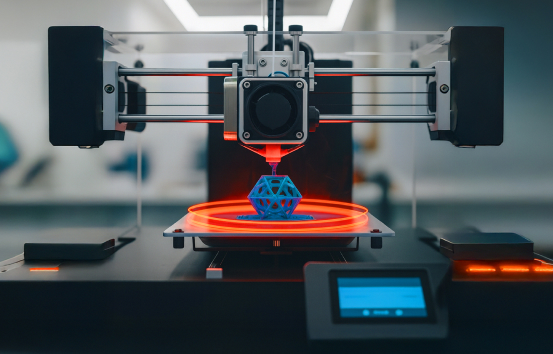Sculpting the Future: Additive Manufacturing Explained Uncategorized March 12, 2025 Introduction A ground breaking innovation known as additive manufacturing, sometimes referred to as 3D printing, is paving the way towards a promising future for the manufacturing sector. In contrast to the conventional production methods, which utilizes subtractive processes to build goods, additive manufacturing provides an upper hand with its flexibility, performance, and personalization. This evolution is an essential part of Industry 4.0, a growing digital revolution in production, fuelled by intelligent automation, smart factories, and the industrial internet. This blog is intended for CTOs, production managers, innovation leaders, and manufacturing specialists. It will assist progressive leaders in staying on the cutting edge by examining the main uses, advantages, difficulties, and revolutionary effects of additive manufacturing. So, whether you’re a conventional manufacturer studying novel methods or a primarily digital innovator building smart factories, this blog will give you useful insights into how 3D printing may decrease residue, cut costs, and increase operating efficiency. Understanding Additive Manufacturing 3-D printing enables creation of complex geometries, enhancement of product design and provision of flexibility in how goods are produced. Over the last decade, it has evolved from being just a tool for quick prototyping to being an essential component of serial production in a variety of industries, including aircraft, electronics, and medical equipment. Another outcome of the industrial sector’s digital revolution is the development of adaptive factories, which leverage adaptable technology, and human-AI cooperation to boost performance whilst reducing lead times. Possessing the ability to produce prototypes upon request and in-house enables businesses to stay competitive, fulfil changing customer expectations, and support objectives like lowering greenhouse gas emissions. As a game-changing technology, which is driving the fourth industrial revolution, it still continues to hold a significant impact on the manufacturing industry. Types of Additive Manufacturing Technologies Fused Deposition Modeling (FDM): One of the most widely used 3D printing procedures, FDM, produces components layer by layer using thermoplastic filaments. This cost-effective method reduces waste materials and accelerates product design testing and prototypes. Stereolithography (SLA): Leveraging laser beams to solidify liquid resins, this method produces extremely precise results. This process has been successfully demonstrated for creating dental molds, electrical parts, and healthcare supplies where the greatest standards of structural uniformity and quality are needed. Selective Laser Sintering (SLS): This method uses a high-powered laser to heat powdered polymers. It is increasingly employed in testing for functionality and serial production for producing robust parts that can withstand real-life scenarios. Direct Metal Laser Sintering (DMLS): By employing powdered alloys the method of DMLS creates metal parts that are sturdy for important applications in the field of aviation, medical, and automotive. It makes a good example of how technological enhancements have led to productive changes in the manufacturing sector. Binder Jetting: This technique joins powdered components with a fluid-based binding agent. It is chosen to produce inexpensive molds and equipment parts quickly that offer scalable and eco-friendly solutions. The output is usually in a “green” state and requires post-processing (e.g., sintering) for strength. The compromises between these methods involve costs, production volume, speed, and materials. Making use of the right approach, production companies can reduce waste, increase performance, and preserve adaptability in a manufacturing industry which is changing rapidly. Additive Manufacturing vs. Traditional Manufacturing Long-standing production methods like CNC machining, foundry, and plastic injection moulding have long established the basis of the manufacturing industry. However, these methods greatly impacted large-scale production with their time-consuming procedures, particularly when creating large quantities of standardized parts, resulting in high installation costs, a requirement for costly equipment, and substantial residue from subtractive processes. On the contrary, additive manufacturing is unlocking new frontiers across high-value industries by allowing design flexibility, on-demand production, and effective resource use. This enhancement aids the production companies to refine and build prototypes swiftly, enabling them to adapt rapidly to changing supply chain conditions and customer demands. In addition to product innovation, additive technologies are significantly influencing the idea of sustainability by reducing waste, lowering greenhouse emissions, and promoting environmentally conscious production methods. As the boundaries between the physical and digital world gets increasingly blurred, advanced data analytics, human-machine interaction, and digital technologies will continue to elevate the benefits of additive manufacturing. This shall allow the manufacturing sector to move closer to a future which is not only economical and flexible but also more inclined towards environment and innovation. Benefits after Adoption Material Efficiency and Reduction of Wastage:This method conserves resources and adheres to eco-friendly standards through cutting on scrap, improving energy consumption, and reducing greenhouse gas emissions by only adding material wherever it is required precisely. On Demand & In-house Manufacturing:Businesses can effectively adjust themselves to shifting demands and output by the production of functional prototypes and spare parts in-house. Especially in sectors of automotive, aerospace, and medicine, this has been shown to be advantageous, since quick adaptability lessens reliance on tight supply chains. Cost Reduction Through New Business Models:The method of 3-D printing creates more adaptable and cost-effective business models by eradicating the use of expensive tools and equipment. It has enabled companies to experiment with cutting-edge strategies such as digital inventory and localized production, and has specifically proven advantageous in production of low-volume and complicated parts. Enabler of Digital Transformation and Smart Factories:Additive manufacturing plays a vital role in the digital shift in the manufacturing sector. Integrated with technologies like artificial intelligence, machine learning, and industrial internet it gives rise to smart factory environments that facilitate agile production. Varied Industrial Applications Aerospace and Automotive: Utilized throughout the automotive sector to create sturdy, lightweight machine parts, like brackets and housings, which can reduce waste and increase efficiency and fuel economy. Consumer Electronics: Helps business operators to react to pattern phases and development by offering short-term manufacturing of housings, fixtures, and interior components along with quick design iterations. Industrial Equipment: Increases the service life of equipment and reduces delays with affordable, on-demand parts that allows speedy replacement of machine components, tools, and jigs. Healthcare: It enables customization and rapid prototyping, reduces lead times, and supports minimally invasive



